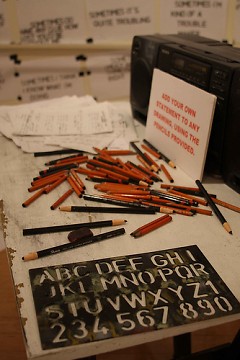From The Rapidian staff: Yesterday afternoon, The Rapidian soft-launched our ArtPrize 2010 page. Here, you will be able to find all of The Rapidian coverage that relates to this year's ArtPrize competition. While regular readers of The Rapidian will find most of this page familiar, there is one main section close to my heart that I want to touch on in particular: Essays & Critique.
We have always been pleasantly surprised by the amount of coverage local arts and entertainment events receive on The Rapidian. At 243 articles, the Arts-Entertainment section is by far the largest section of The Rapidian by a substantial amount (and I mean substantial). Thus far, these articles have consisted primarily of event recaps and artist profiles, the occasional album or film review, and the rare critical look at a local visual art show. In fact, it’s worth pointing out that while Arts-Entertainment is our largest content section, only about 10 percent are also categorized as “Review” (26 total).
These numbers have had some of us around The Rapidian HQ thinking quite a bit about the state of critical discourse in Grand Rapids. It is clear that Grand Rapids is truly passionate about arts and culture, but these statistics indicate hesitation to take that passion to the next level of analysis, at least on The Rapidian.
Working with the local arts community, I can assure you that this reflects the state of affairs “offline” as well. Over the years I have heard laments about the lack of meaningful, critical dialogue in Grand Rapids. Lots of work is displayed year-round and all sorts of meaningful conversations happen in private or in a small group setting, but too seldom are these things talked about in a truly public setting or in media.
This is especially true with regards to ArtPrize. Just yesterday, Elizabeth VanArragon reminded us that there is a plethora of art education programming surrounding ArtPrize. From the officially sanctioned lunchbox series to the parallel sessions to the counter actions, there are ample opportunities to talk about art in a wide variety of settings. But, if the past year is any indication, very little of these exchanges will be synthesized into published critical work, at least not locally.
Responding directly to this need, we gathered together a group of initial correspondents to critically cover some of the work and issues presented by this year’s ArtPrize. Over the course of the competition, these correspondents help provide our overall collective coverage of ArtPrize with a backbone of art criticism, something that we felt was sorely lacking in previous coverage of the competition. The intention here is not to create an "elite" circle of experts so much as to seed a specific content area that will be fleshed out by the rest of us over the upcoming weeks. The Rapidian is an open format for citizen journalism, and we hope that the circle of contributors submitting work of a critical nature will grow quickly and naturally. The goal here is to foster a complex dialog that helps more of us get in the habit of criticism, hopefully growing to the point of establishing a group of ongoing critics excited to spread the word about our burgeoning arts community. We've just got to get that ball rolling.
Like ArtPrize, The Rapidian is entering its second year and, quite hopefully, coming of age. Part of our maturation process is coming to terms with the fact that arts coverage should be about more than just exposing people to something they have never experienced before, but about helping them critically digest it as well. It is certainly about “what happened,” but it’s also about why whatever happened was good (or not) or why it matters (or doesn't). This kind of analysis helps create a fuller record of just exactly what we are up to around here and presents us as an community willing to take ourselves and the products of our visual culture seriously.
The Rapidian, a program of the 501(c)3 nonprofit Community Media Center, relies on the community’s support to help cover the cost of training reporters and publishing content.
We need your help.
If each of our readers and content creators who values this community platform help support its creation and maintenance, The Rapidian can continue to educate and facilitate a conversation around issues for years to come.
Please support The Rapidian and make a contribution today.


Comments
i wholeheartedly agree. i'm glad you brought this to light.
I appreciate the insight you offer when you say...
"Part of our maturation process is coming to terms with the fact that arts coverage should be about more than just exposing people to something they have never experienced before, but about helping them critically digest it as well."
Unfortunately ArtPrize is constructed just the opposite. Rick Devos has designed an art competition thats goes out of it's way to avoid critical knowledge. According to ArtPrize artists are not juried into the competition they are "matched". In reality that's not really true. Artists pay a $50 application fee and then are juried into venues by unknown people some who may or may not know anything about jurying art. And those people are never disclosed to the applicants or the viewing public. Why? Because it doesn't fit the ArtPrize model that you don't need knowledge about art. You just need to come to Grand Rapids, stay at it's hotels and eat at it's restaurants and vote.
some of the "venues" are not soo hot either...like the "park" at the intersection of State/Cherry/Madison.... it is 60 sg ft of grass covered median and a few trees.... the only thing over there is the sketchy liquor store frequented by the heartside social services patrons... most of whom probably are not artprize voters
That's a pretty insulting comment to the Heritage Hill residents who live around this park, and to the volunteer gardeners who try and maintain it. Sure, Clark's is there, but if you look around you'll see this park is in the middle of a beautiful neighborhood. Oh and I'm sure that many "social service patrons" are voting in ArtPrize. Elitist much?
As a neighbor of this park, I tend to agree with the Amy here. Additionally, I am sure not every venue is going to be appropriate for every artist - but a creative person could really work with 60 sq.ft. of grass and a few trees. While I am not intimately aware of how the artist/venue matchup works in ArtPrize, I know that confirmation is a two way street. Both the artist and the venue should be fully aware of what they are getting in to. Right?
George,
It's a misnomer to say that the "matching" is a two way street. It's not. The venue picks, selects, juries,who they want for their venue. Sure artists apply to various venues but that in itself is problematic. If you are an artists from Texas looking for an outdoor venue how are you to know the complete environmental characteristics of the space